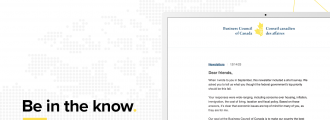The Trade Brief: Spooky szn edition
Boo👻
Some people saw ghosts in October, we just saw scary headlines.
Welcome back to the Trade Brief, where:
- Canada-U.S. feud is scarier than your neighbour’s DIY costume,
- Tariffs lurk like ghosts,
- The 2025 budget is the ultimate trick-or-treat, and
- Asia & Critical Minerals are the haunted house with the candy stash inside
So, clutch your half-eaten candy bags because things are about to get spooky.
Authors note: The trade part of the Trade Brief, my co-founder, Daniela Lombardo, is unfortunately leaving us to conquer new worlds and we’ll miss her like crazy 🥲 but rest assured, the Trade Brief isn’t ghosting you. It will continue to live every month with help from our BCC team and 48399273 news stories.
Alas, let’s get into it.
Canada-U.S. SPAT: Where do we go from here?
We kicked off October on a high note.
Optimism was in the air as Prime Minister Mark Carney made his second visit to the White House suggesting progress in talks and even whispers of a Canada-U.S. tariff agreement before the PM and President Donald Trump met again at the Asia-Pacific Economic Cooperation Summit (APEC).
What could possibly go wrong?
Cue the spicy ad from the Ontario government that ultimately derailed the negotiations.
Featuring parts of a speech by former U.S. President Ronald Reagan, the ad didn’t make tariffs look pretty. 😱
The Ronald Reagan Presidential Foundation was not pleased with the ad and said it “misrepresents” the speech.
If you’re curious, here is the full speech and here is the Ontario ad.
What followed?✨ Drama.✨
Heated exchanges, threats of more tariffs (10% more, to be precise), spicy op-eds, more drama and all sorts of theories.
So, what does this all mean? And, where do we go from here?
The paused talks were reportedly on sectoral tariffs (Section 232, a.k.a. “national security tariffs”) separate from the larger USMCA trade agreement.
⌛Reminder: the three countries are set to decide by July 2026 whether to extend the deal past the year 2036. The three governments 🇺🇸🇨🇦🇲🇽 all undertook consultations on the matter.
The risk? Time🕰️
The longer we go without a deal, the more uncertainty we face and the more harm tariffs will cause to impacted sectors.
That translates into less spending, less investment, more anxiety for Canadian businesses.
Meanwhile, 🇲🇽 Mexico is moving full speed ahead on its own tariff agreement. And don’t forget the wildcard 🃏 – the U.S. Supreme Court is now reviewing the legality of President Trump’s other tariffs: those International Emergency Economic Powers Act (IEEPA) ones.
And even if the U.S. Supreme Court were to strike down the IEEPA tariffs, it doesn’t necessarily mean good news for Canada.
The silver lining?
Most Americans (even Republicans) still think fondly of Canada.

TARIFFS EXPOSED: AN X-RAY OF PAIN POINTS
Ask how the trade dispute is going and you’ll hear everything from ‘we’re doomed’ to ‘we’re fine’ and one person blaming the Pluto retrograde.
Classic trade energy.
Let’s break it down:
🚗Autos:
- General Motors announced it’s pulling the plug on its BrightDrop electric vans in Ingersoll, Ontario. (Pun intended 😉)
- Stellantis disclosed it’s shifting production from Brampton, Ontario to the U.S.
Ottawa’s response?
- The government decided to scale back the number of tariff-free vehicles the above companies can import.
- And it launched a dispute-resolution process.
The Canadian Federation of Independent Business reported that almost half – 49% – of auto businesses in Ontario have paused or cancelled investments, that’s about C$2.9B in missed investment over the next year.
🇺🇸 As of Nov. 1, the U.S. slapped 25% tariffs on medium and heavy trucks, plus 10% on buses – on top of steel and aluminum tariffs. Smh.
Meanwhile, U.S. automakers are somehow managing thanks to exemptions and regulatory loopholes.

🌽Canola:
China hit Canadian canola seeds with a 75.8% tariff (not great when they’re your #2 export market).
The industry’s asking for more government help, saying uncertainty is messing with crop planning and prices.
Farmers are keeping crops in their bins, waiting for better prices.
FYI: The last time there was a canola trade disruption with China, it cost the industry between C$1.5- C$2.5 billion.
China hinted that tariffs could be lifted if Canada drops its 100% tariff on EVs. But it appears that’s a “hard no” from the Canadian auto sector. Yikes.
🌳Forestry:
Canadian softwood lumber faces a 45% tariff entering the U.S. – higher than Russia’s. Yeah…..
With 78% of exports going south, the industry is on edge and wants to be prioritized in ongoing negotiations.
Meanwhile, in the U.S.? Businesses keep absorbing tariffs like it’s no biggie.
CANADA’S 2025 BUDGET
📖Chapter 2 of the federal budget read like a trade war survival guide. Big feature.
- C$12B/year for five years to support industries feeling the tariff pinch.
- Think: diversifying markets and products, loans, compensation, reskilling, and yes, a little “here’s some help, hang in there.👍”
- Big “wow” moment in the budget was the goal to double non-U.S. exports in the next ten years, adding C$300 billion in trade.
To get there:
- C$5 billion for trade infrastructure over seven years.
- New Strategic Exports Office. A fancy way of saying: “We’ll find deals, cut red tape, and make your life slightly less painful.”
Here’s our full take on the 2025 Budget.
THE GLIMMER OF HOPE
Asia bound
You might have noticed most world leaders were in Asia in October.
They were busy hopping between two major world events: the Association of Southeast Asian Nations (ASEAN) Summit in Malaysia and the Asia-Pacific Economic Cooperation Summit (APEC) in Korea.
Lots of handshakes🤝, deals📜, toasts🥂, gifts 🎁, …..and probably some very awkward selfies🤳.
The TL;DR version:
- 🇺🇸🇨🇳U.S.-China: 1-year deal = fewer tariffs, eased export controls, and China buying more U.S. farm products.🥩🌾
- 🇨🇦🇨🇳PM Carney + President Xi: first sit-down between leaders since 2017. Long overdue.🕰️
- U.S. inks ✒️ deals with Thailand, Malaysia, Cambodia, Vietnam. (Talk about regional networking 🗺️)
- 💻Tech triad: U.S., Japan, South Korea tech deal signed. Big brain energy.🧠⚡
Critical Minerals
The hot buzz term🔥 in October: critical minerals.
- It was a key 🔑 theme in the U.S.-China negotiations.
- U.S. signed deals with Japan,Thailand, Malaysia to diversify supply chain.
- Many other countries are looking to hop on the bandwagon.
- Canada’s G7 Critical Minerals Action Plan (from June) moves from “paper” to “action”.
- 26 projects unlocking C$6.4Billion in critical mineral projects.
- Canada will also start to stockpile graphite ✏️ and scandium – making them new collectors’ items.
IN CONCLUSION
Trade tensions? Icy. Deals? Slow. But Mariah Carey thawing reminds us that the frost doesn’t last forever.😉

See you next month!










